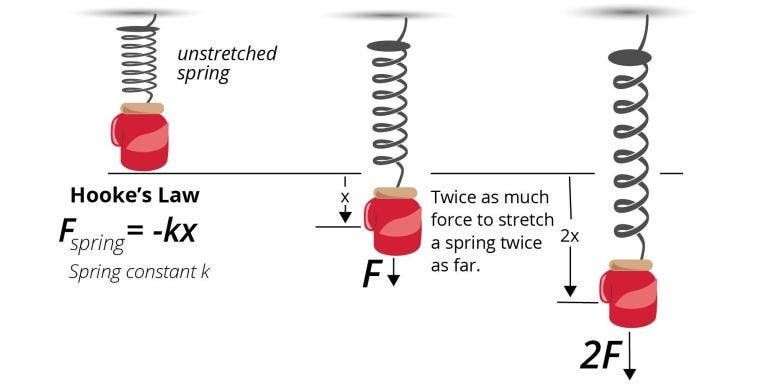Hookes Law - Understanding Definition, Formula, and Graph
Physics is a realm of understanding, interpreting, and leveraging the natural world around us. Hookes Law is a cornerstone concept among its many principles and laws. The law is critical in fields like engineering, design, architecture, and even medicine.
What is Hookes Law?
Emerging from Robert Hooke's 17th-century explorations of elasticity and springs, Hookes Law Formula explains the linear relationship between the spring’s extension and the force applied to it. This law shows that within specific constraints, the elastic object’s extension, such as a metal spring, is directly proportional to the applied force.
Its applications span from the intricacies of mechanical watchmaking to engineering advanced suspension systems in automobiles.
Hookes Law Formula
The Hookes Law formula is elegantly simple:
F = - kx
In this equation, 'F' denotes the force exerted, 'x' reflects the displacement of the spring from its equilibrium, and 'k' is the spring constant that is unique to each spring.
The formula's negative sign signifies that the spring's restoring force counteracts the displacement-causing force - meaning that pulling a spring downwards extends it in the same direction, which prompts an upward restoring force from the spring.
Applying Hooke's Law to practical problems demands an accurate understanding of this force direction. In simpler contexts, we often regard the extension 'x' as a 1-dimensional vector, giving rise to a likewise 1-dimensional resultant force vector. The negative sign in Hooke's Law thus accurately points to the force's direction.
Moreover, to compute 'x,' we must account for the spring's nominal length (L0). The total length of an extended spring (L) equals its nominal length plus the extension (L = L0 + x). If the spring is compressed, the total length equals the nominal length minus the extension (L = L0 - x).
This comprehensive understanding of Hooke's Law aids in accurately applying this principle across scientific and real-world applications.
Hooke's Law Graph
The Hooke's Law graph offers a visual interpretation of this foundational principle. On this graph, the y-axis symbolizes the force (F), while the x-axis represents the displacement (x). Given the law's linear nature, the graph showcases a straight line passing through the origin, reflecting the force's direct proportionality to displacement.
Understanding Hooke's law is essential in physics and various applied fields. It allows engineers and designers to predict how materials will behave under strain and helps design better, safer products. Mastering these principles requires practice and, most importantly, the right laboratory supplies. Using top-quality equipment ensures accuracy and reliability in your results.
At Westlab Canada, we are committed to facilitating the best learning and researching experience for everyone. Our range of superior physics lab instruments meets and exceeds professional standards, enabling accurate experimentation and learning.
Westlab Canada - Get the Best Physics Lab Instruments
Whether undertaking a Hooke's Law lab experiment or exploring other areas of physics, trust Westlab Canada to provide the best quality laboratory supplies. Our commitment to excellence and reliability ensures that you can focus on your work, confident in the knowledge that the tools in your hands are of the highest quality. Remember, every great scientific discovery starts with the right tools.
FAQs
1. How can Hooke's law be verified in a laboratory?
Verification of Hooke's law can be performed through a simple Hooke Law lab experiment involving a spring, a series of weights, and a meter stick for measuring the spring's extension.
2. What happens when the limit of Hooke's law formula is exceeded?
Once the limit of Hooke's law formula is exceeded, materials may deform permanently, a state known as plastic deformation.
3. Can Hookes law be applied to all materials?
Hooke's law applies to many materials under ordinary conditions. However, the law's validity diminishes with materials that do not exhibit linear elastic behavior.
4. How is Hookes law used in real-life situations?
Hooke's law is instrumental in designing numerous everyday objects, from car suspensions to mattress springs and load-bearing structures in architecture.


